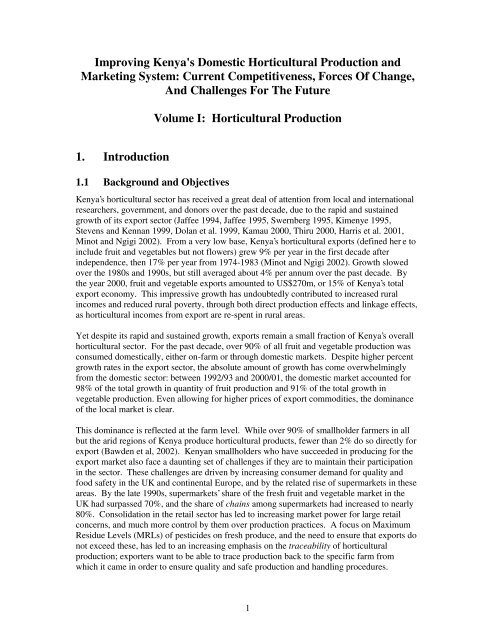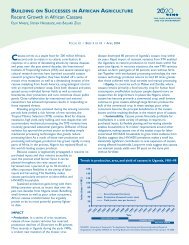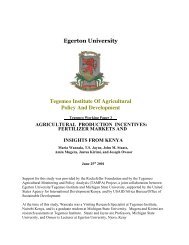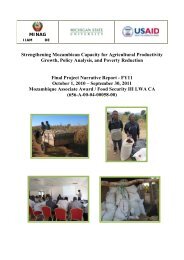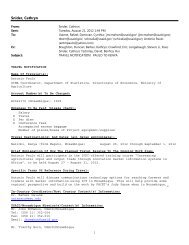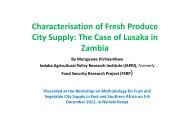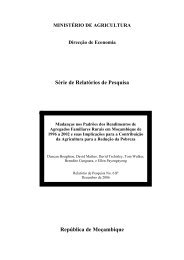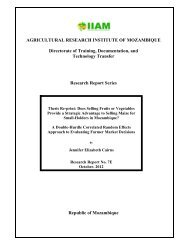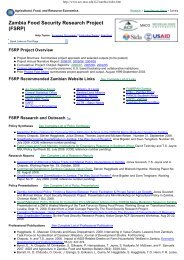Improving Kenya's Domestic Horticultural Production and Marketing
Improving Kenya's Domestic Horticultural Production and Marketing
Improving Kenya's Domestic Horticultural Production and Marketing
You also want an ePaper? Increase the reach of your titles
YUMPU automatically turns print PDFs into web optimized ePapers that Google loves.
<strong>Improving</strong> <strong>Kenya's</strong> <strong>Domestic</strong> <strong>Horticultural</strong> <strong>Production</strong> <strong>and</strong><br />
<strong>Marketing</strong> System: Current Competitiveness, Forces Of Change,<br />
And Challenges For The Future<br />
1. Introduction<br />
1.1 Background <strong>and</strong> Objectives<br />
Volume I: <strong>Horticultural</strong> <strong>Production</strong><br />
Kenya’s horticultural sector has received a great deal of attention from local <strong>and</strong> international<br />
researchers, government, <strong>and</strong> donors over the past decade, due to the rapid <strong>and</strong> sustained<br />
growth of its export sector (Jaffee 1994, Jaffee 1995, Swernberg 1995, Kimenye 1995,<br />
Stevens <strong>and</strong> Kennan 1999, Dolan et al. 1999, Kamau 2000, Thiru 2000, Harris et al. 2001,<br />
Minot <strong>and</strong> Ngigi 2002). From a very low base, Kenya’s horticultural exports (defined her e to<br />
include fruit <strong>and</strong> vegetables but not flowers) grew 9% per year in the first decade after<br />
independence, then 17% per year from 1974-1983 (Minot <strong>and</strong> Ngigi 2002). Growth slowed<br />
over the 1980s <strong>and</strong> 1990s, but still averaged about 4% per annum over the past decade. By<br />
the year 2000, fruit <strong>and</strong> vegetable exports amounted to US$270m, or 15% of Kenya’s total<br />
export economy. This impressive growth has undoubtedly contributed to increased rural<br />
incomes <strong>and</strong> reduced rural poverty, through both direct production effects <strong>and</strong> linkage effects,<br />
as horticultural incomes from export are re-spent in rural areas.<br />
Yet despite its rapid <strong>and</strong> sustained growth, exports remain a small fraction of Kenya’s overall<br />
horticultural sector. For the past decade, over 90% of all fruit <strong>and</strong> vegetable production was<br />
consumed domestically, either on-farm or through domestic markets. Despite higher percent<br />
growth rates in the export sector, the absolute amount of growth has come overwhelmingly<br />
from the domestic sector: between 1992/93 <strong>and</strong> 2000/01, the domestic market accounted for<br />
98% of the total growth in quantity of fruit production <strong>and</strong> 91% of the total growth in<br />
vegetable production. Even allowing for higher prices of export commodities, the dominance<br />
of the local market is clear.<br />
This dominance is reflected at the farm level. While over 90% of smallholder farmers in all<br />
but the arid regions of Kenya produce horticultural products, fewer than 2% do so directly for<br />
export (Bawden et al, 2002). Kenyan smallholders who have succeeded in producing for the<br />
export market also face a daunting set of challenges if they are to maintain their participation<br />
in the sector. These challenges are driven by increasing consumer dem<strong>and</strong> for quality <strong>and</strong><br />
food safety in the UK <strong>and</strong> continental Europe, <strong>and</strong> by the related rise of supermarkets in these<br />
areas. By the late 1990s, supermarkets’ share of the fresh fruit <strong>and</strong> vegetable market in the<br />
UK had surpassed 70%, <strong>and</strong> the share of chains among supermarkets had increased to nearly<br />
80%. Consolidation in the retail sector has led to increasing market power for large retail<br />
concerns, <strong>and</strong> much more control by them over production practices. A focus on Maximum<br />
Residue Levels (MRLs) of pesticides on fresh produce, <strong>and</strong> the need to ensure that exports do<br />
not exceed these, has led to an increasing emphasis on the traceability of horticultural<br />
production; exporters want to be able to trace production back to the specific farm from<br />
which it came in order to ensure quality <strong>and</strong> safe production <strong>and</strong> h<strong>and</strong>ling procedures.<br />
1


